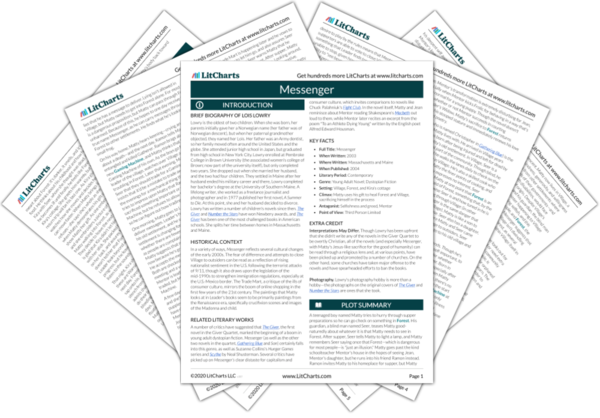Welcome to the LitCharts study guide on Lois Lowry's Messenger. Created by the original team behind SparkNotes, LitCharts are the world's best literature guides.
Messenger: Introduction
Messenger: Plot Summary
Messenger: Detailed Summary & Analysis
Messenger: Themes
Messenger: Quotes
Messenger: Characters
Messenger: Symbols
Messenger: Theme Wheel
Brief Biography of Lois Lowry

Historical Context of Messenger
Other Books Related to Messenger
Key Facts about Messenger
- Full Title: Messenger
- When Written: 2003
- Where Written: Massachusetts and Maine
- When Published: 2004
- Literary Period: Contemporary
- Genre: Young Adult Novel; Dystopian Fiction
- Setting: Village, Forest, and Kira's cottage
- Climax: Matty uses his gift to heal Forest and Village, sacrificing himself in the process
- Antagonist: Selfishness and greed, Mentor
- Point of View: Third Person Limited
Extra Credit for Messenger
Interpretations May Differ. Though Lowry has been upfront that she didn't write any of the novels in the Giver Quartet to be overtly Christian, all of the novels (and especially Messenger, with Matty's Jesus-like sacrifice for the good of humanity) can be read through a religious lens and, at various points, have been picked up and promoted by a number of churches. On the other hand, some churches have taken major offense to the novels and have spearheaded efforts to ban the books.
Photography. Lowry's photography hobby is more than a hobby—the photographs on the original covers of The Giver and Number the Stars are ones that she took.







